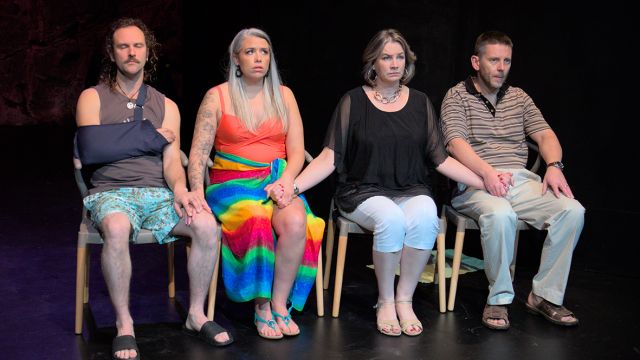The Gift
An adult of my acquaintance once admitted, somewhat shallowly, that they admired the musical Into the Woods but wished it finished at interval. If it did, Sondheim’s meaning and intention would not have been realised. The Gift has a similar problem in reverse. Act One of The Gift establishes everything necessary to comprehend the complexity of the extended climax of Act Two… but I wish it started at intermission.
The second Act of The Gift by Australian playwright Joanna Murray-Smith is compelling. The opening night audience in Hobart was invested in the characters and their dilemma, a dilemma which could not have been appreciated without the preceding exposition.
A wealthy older couple, jaded and bored, meet a younger, struggling artistic couple at a resort. Each has what the other desires. Ed and Sadie have gorged on all that money can buy but are spiritually bankrupt. Martin and Chloe have a zest for life but envy the freedom and stability of the older couple. This relationship is explored in 60 minute of witty repartee and a yachting accident.

The four leads are experienced and capable performers. Andrew Casey is particularly impressive in the second act after an epiphany enables his character, Ed, to become “switched on to life”. Prior to that he is a quite abhorrent character; he and wife, Sadie, stuck in their 30-year routine of trite and affectatious opinions. Both Casey and, to a lesser degree, Clare Pearson, as Sadie, navigate a knife edge where the hazard inherent in the script is to alienate the audience rather than garner sympathy. Both become real and rounded in Act Two.
The character of Sadie breaks the fourth wall on several occasions but only during Act One. This is lazy storytelling and largely unnecessary. Pearson is forced to remove herself from the scene, interrupting the flow of action, to narrate the progress of the new friendship she and Ed make with Martin and Chloe. There is no return to this device in Act Two which feels more assured and gives the actors more dramatic scope. The audience has no difficulty in observing the trajectory of the climax and the reactions of those involved without commentary from Sadie. The speeches made directly to the audience are jarring but do enable Pearson to portray a more sympathetic Sadie, one who has lost something of the person she was in the past.

There is much discussion in The Gift about the nature and purpose of art, in particular conceptual and installation art, and this dominates Act One. The idea that in receiving art, the viewer completes it, is an idea postulated in the first half that becomes relevant later. So does the description of a specific artwork. The artwork is made from light, an insubstantial an ephemeral projection of the idea rather than the substance of the subject.
Chris Jackson plays Martin, the artist. The character is unpretentious but only becomes fully realised in act two. Again, this is no fault of the performer but a very wordy script, the burden of which must have been felt by all. Jackson was best in humorous moments, which abound. The “dog” story was a fun episode between Jackson and Tia Landeg, as Chloe.
In a story about unfulfilled desires, lost opportunities and irrevocable mistakes, Chloe is a character who is written in such a way that her aspirations are not evident. Landeg makes her sympathetic and real, albeit inexplicable, in act two. The idea that the freedom to pursue artistic endeavour and exigencies of real life are somehow incompatible, seems a little self indulgent.

The set is simple but stylish and functional, with black and white the motif of the second act. The whole is unified by a soundscape by Matt Harris. Jazz inspired, the opening modulations and discords, hint at the dissonance to come. James’ lighting has a special moment at the end where Martin’s idea conceptual work is realised, reinforcing the idea of a gift as both an idea and reality.
Murray-Smith’s script is dense and wordy, and a marathon effort for the four performers. Where it is deficient can be forgiven when all is revealed. Disposable friendships, as described in the first moments of the play, become enduring connection at the end.
Anne Blythe-Cooper
Photographer: Wayne Wagg
Subscribe to our E-Newsletter, buy our latest print edition or find a Performing Arts book at Book Nook.

